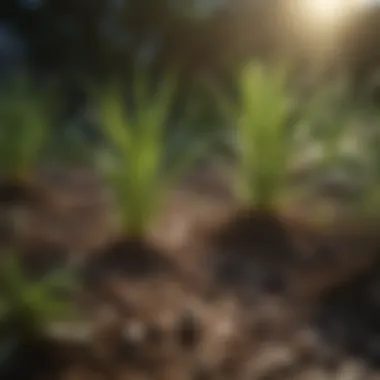Effective Fertilization Techniques for St. Augustine Grass


Overview of the Topic
Definition and Importance
St. Augustine grass is a warm-season turf, known for its rich green color and dense growth, making it a popular choice for lawns, parks, and golf courses. Its ability to withstand heat and humidity is crucial in many regions, particularly in the southern United States. For optimal growth, effective fertilization techniques are necessary. Proper fertilization not only supports healthy growth but also enhances the lawn's resilience against pests and diseases.
Current Trends
Currently, there is an increasing awareness around sustainable practices in lawn care. Eco-friendly fertilizers, organic options, and timed applications align with efforts to protect the environment while also maintaining vibrant turf. Discussions in various forums, such as Reddit, often highlight the need for smarter fertilization strategies. Users share experiences and tips, fostering a community focused on improving turf health without harming the ecosystem.
Key Techniques and Practices
Step-by-Step Guide
- Soil Testing: Understanding the nutrient levels in the soil is the first step. Testing kits can reveal pH levels and essential nutrient shortages, guiding tailored fertilization strategies.
- Choosing the Right Fertilizer: St. Augustine grass thrives with nitrogen-rich fertilizers. Slow-release products are preferable as they provide nutrients over time, fostering continuous growth. Recommended brands include Scotts Turf Builder and Miracle-Gro.
- Application Timing: Fertilization should typically occur in the growing season, preferably in early spring and mid-summer. Late fall applications are usually unnecessary and may even damage the grass.
- Proper Technique: Spreading fertilizers evenly across the lawn prevents nutrient hotspots. Hand-held spreaders or broadcast spreaders can serve this purpose effectively.
- Watering: After applying fertilizer, it is essential to water the grass thoroughly. This helps activate the nutrients and reduces potential burn from concentrated fertilizer granules.
Tools and Equipment Needed
- Soil testing kit
- Broadcast or drop spreader
- Fertilizer appropriate for St. Augustine grass
- Watering system, such as a hose or irrigation system
Challenges and Solutions
Common Obstacles
Maintaining St. Augustine grass comes with challenges. Over-fertilization can lead to rapid growth but also increases vulnerability to diseases. Additionally, under-fertilization may cause yellowing and poor overall appearance. Adverse weather conditions, like droughts, can further complicate efforts, making nutrient distribution uneven.
Innovative Solutions
To counter these challenges, consider the following strategies:
- Regular Monitoring: Frequent assessments of grass health can help catch issues early, allowing for timely interventions.
- Foliar Feeding: This method involves spraying liquid fertilizers directly onto the grass blades. It can provide quick nutrient absorption and is helpful when soil conditions are poor.
- Sustainable Options: Organic fertilizers and compost can enhance soil health over time without the harsh impacts of chemical fertilizers. Incorporating these methods can promote longevity and sustainability in lawn care.
Regularly monitoring St. Augustine grass health is a key strategy. It aids in catching potential nutrient deficiencies early.
Understanding St. Augustine Grass
Understanding St. Augustine grass is crucial for anyone interested in effective turf management. This grass variety boasts unique characteristics that can determine its best growth conditions and maintenance needs. Identifying these traits helps farmers and turf enthusiasts create strategies that promote strong, healthy grass.
When considering St. Augustine grass, its adaptability to various environments plays a significant role. This type of grass thrives in warm, humid climates. Knowing this provides insight into optimal growth periods and suitable fertilization techniques. Additionally, learning about its growth habits, including its spread through stolons, informs management decisions related to mowing and irrigation.
Incorporating an understanding of soil requirements and local climate can also improve fertilization efficacy. The grass prefers slightly acidic soil with a pH between 5.0 and 7.0. Understanding these elements can lead to targeted amendments and improved nutrient uptake.
Characteristics of St. Augustine Grass
St. Augustine grass has distinct characteristics that set it apart from other turf types. It is a robust, warm-season grass known for its broad, flat blades that have a smooth texture. The color ranges from rich green to dark blue-green, providing an appealing aesthetic to residential landscapes or recreational areas.
The growth pattern of St. Augustine grass is particularly interesting. It spreads through stolons, which are above-ground runners. This growth habit allows for thick coverage, making it an effective choice for lawns, parks, and golf courses. However, this same characteristic can create maintenance challenges, as it can encroach on flowerbeds and other landscape features.
Its tolerance to heat and moderate drought conditions enhances its utility in regions prone to warm weather. However, it requires sufficient moisture to maintain its lush appearance, which is something to address when considering irrigation strategies.
Common Uses and Benefits
St. Augustine grass is versatile and is commonly utilized in various settings. It is frequently chosen for residential lawns due to its lush appearance and ability to thrive in warm climates. The thick canopy provides excellent ground coverage, making it visually appealing and reducing weed growth.
In addition, its durability makes it suitable for high-traffic areas such as playgrounds and athletic fields. The ability to maintain aesthetics alongside function is valuable for these applications. Furthermore, St. Augustine grass offers a comfortable playing surface, which is important for sports and recreational activities.
Not only does this grass type present aesthetic benefits, but it also assists in soil erosion control. Its strong root system helps stabilize the soil, preventing runoff and promoting healthier soil conditions.
In summary, understanding St. Augustine grass means recognizing its characteristics and benefits, which ultimately informs suitable fertilization techniques. With this knowledge, one can tailor their approach to fertilization and maintenance, leading to more resilient and vibrant turf.


Nutritional Needs of St. Augustine Grass
Understanding the nutritional needs of St. Augustine grass is foundational for anyone looking to cultivate a lush and resilient lawn. This grass type thrives in warm climates and on nutrient-rich soils. Without proper nourishment, the grass can succumb to pests, diseases, and environmental stresses. The relationship between nutrition and the health of St. Augustine grass cannot be overstated. It directly affects growth, color, and density, which are essential for both aesthetic appeal and functionality.
Essential Nutrients
St. Augustine grass has several key nutrients it requires for optimal growth. These include:
- Nitrogen (N): Crucial for leaf and shoot development. It encourages vibrant green color and healthy growth. Regular nitrogen feeding can help achieve denser turf.
- Phosphorus (P): Important for root growth and early establishment. It aids in photosynthesis and energy transfer within the grass.
- Potassium (K): Enhances overall plant health, improves drought resistance, and aids in stress tolerance. It also plays a role in disease resistance.
- Micronutrients: Elements like iron, magnesium, and calcium are needed in smaller amounts but are vital for various biochemical processes in the grass.
The balance of these nutrients is important. Using a fertilizer that contains a suitable ratio of N-P-K helps meet the specific nutritional needs of St. Augustine grass throughout the growing season.
Symptoms of Nutrient Deficiencies
When St. Augustine grass lacks necessary nutrients, it exhibits clear symptoms. Identifying these early can prevent significant lawn damage. Common signs of nutrient deficiencies include:
- Yellowing Leaves: A sign of nitrogen deficiency. If the grass blades turn pale or yellow, it may require more nitrogen.
- Poor Root Development: Limited phosphorus can lead to weak roots, which makes the grass more susceptible to stress.
- Weak Growth: Stunted growth may indicate a potassium deficiency.
- Interveinal Chlorosis: Yellowing between the veins of leaves can signal iron deficiency, common in alkaline soils.
Regular soil testing is essential to determine the specific needs of your lawn. Through proper analysis, gardeners can adjust fertilization practices to promote robust growth and overall health.
"Regular soil testing allows for tailored nutrient management, ensuring St. Augustine grass reaches its full potential."
Choosing the Right Fertilizer
Choosing the right fertilizer is essential when caring for St. Augustine grass. This grass type thrives in specific nutrient conditions. Selecting the appropriate fertilizer ensures that the grass receives the right nutrients at the correct times. Each fertilizer has unique properties that cater to varying needs. Understanding these can significantly impact the overall strength and appearance of the lawn.
Types of Fertilizers
Granular Fertilizers
Granular fertilizers are popular choices for St. Augustine grass. They consist of small particles that slowly release nutrients over time. This aspect allows for prolonged feeding, which is beneficial during the growing season. A key characteristic of granular fertilizers is their ease of application. You can spread them using a broadcast spreader, ensuring even coverage across the lawn.
One unique feature is the variety of formulations available. Some granular fertilizers are slow-release, which minimizes the risk of nutrient leaching. However, the disadvantage is that they require rain or additional watering for activation. Consequently, maintaining the right moisture level is crucial for effectiveness in this article.
Liquid Fertilizers
Liquid fertilizers offer rapid nutrient absorption, making them advantageous for St. Augustine grass. One of the key characteristics is their immediate availability for the plants. They can quickly improve turf color and vigor when applied during peak growth periods. Liquid fertilizers work well in tandem with a foliar feed method, where nutrients are sprayed directly onto the grass blades.
A unique advantage is the flexibility of application. Liquid options can be adjusted based on specific needs or deficiencies observed. However, their frequent application is often necessary to maintain nutrient levels, which can lead to increased labor and potential runoff into water sources if not monitored properly.
Organic Options
Organic fertilizers are gaining traction for their environmental benefits. They enhance soil health while providing essential nutrients for St. Augustine grass. The key characteristic of organic options is that they are derived from natural materials. This allows for gradual nutrient release, which helps improve soil structure and microbial activity.
A unique feature is the low risk of over-fertilization. Organic fertilizers usually contain lower concentrations of nutrients, promoting a more balanced growth. Nevertheless, the downside can be slower results compared to synthetic fertilizers. This means patience is often required to see significant effects from organic fertilization in this article.
Understanding N-P-K Ratios
Knowing the N-P-K ratio is crucial in selecting fertilizers. N-P-K stands for nitrogen, phosphorus, and potassium. Each plays an important role in plant health. For St. Augustine grass, nitrogen supports growth and green color, phosphorus aids root development, and potassium enhances overall resilience. Understanding these ratios help ensure your selection aligns with the specific needs of your lawn.
Timing Your Fertilization
Timing your fertilization is a crucial aspect when it comes to promoting the optimal health and growth of St. Augustine grass. Proper timing not only enhances nutrient uptake but also minimizes potential damage caused by environmental factors. It is important to align fertilizer application with the grass’s growth cycle and the local weather conditions. By selecting the right times to fertilize, you can ensure that your grass receives the nutrients it needs without unnecessary risks.
Seasonal Fertilization Schedule
A seasonal fertilization schedule is key to ensuring that St. Augustine grass continues to thrive. Generally, the best times for fertilizing this grass are during the growing season, which typically spans from late spring to early fall. Specifically, applying fertilizer in early spring can promote lush growth as the grass awakens from dormancy. A mid-season application, around summer, supports continued health as temperatures rise. It is advisable to avoid fertilizing in late fall, as this can precipitate weak growth heading into dormancy.
Key considerations for establishing a fertilization schedule:
- Early Spring: Fertilize when temperatures are regularly above 65°F.
- Mid-Summer: A second fertilization helps sustain growth during peak heat.
- Late Summer/Fall: Avoid fertilization to prevent stimulating growth before winter.


Factors Affecting Timing
Climate Considerations
Climate conditions significantly influence the appropriate timing for fertilization. Warmer climates, typical for St. Augustine grass, generally allow for earlier applications compared to cooler regions. Grass growth largely depends on temperature and moisture levels. In subtropical areas, early spring applications coincide with increased soil warmth, which facilitates nutrient absorption. Conversely, in cooler climates, delayed fertilization might be necessary to avoid negative effects on grass health.
One unique characteristic of considering climate is the seasonal variation in rainfall. Heavy rains can wash away fertilizers, leading to inefficiencies. Therefore, monitoring local weather patterns is essential to align fertilization schedules effectively.
Growth Stages
Understanding the growth stages of St. Augustine grass can markedly affect fertilization timing. The grass typically transitions through a few growth phases: emergence, active growth, and dormancy. Fertilizing during the active growth phase, specifically in spring and summer, ensures that nutrients are effectively used for photosynthesis and turf density improvement.
A key characteristic during the active growth phase is the grass’s higher nutrient uptake capability. Timing applications so that they coincide with this vital growth stage can lead to robust development. However, mis-timed applications during early dormancy can lead to lesions or stress, which negatively impacts the grass.
In summary, timing your fertilization involves attention to seasonal schedules and awareness of climate and growth stage dynamics. Properly executed, this approach can yield healthy and vibrant St. Augustine grass, aligning closely with its natural growth rhythm.
Application Methods for Fertilizer
Understanding various application methods for fertilizer is crucial for maintaining the health of St. Augustine grass. The application approach directly influences nutrient uptake, growth rate, and turf resilience. Each method has its own set of techniques, timing, and benefits, which depend on specific factors such as soil condition, grass stage, and environmental factors.
Effective fertilization enhances the grass's ability to withstand drought, resist pests, and maintain aesthetic appeal. Knowing the suitable methods allows farmers and lawn enthusiasts to make informed decisions that will yield healthier, denser grass.
Broadcast Application
Broadcast application is a widely used technique for distributing granular fertilizer across a large area effectively. It involves uniformly spreading the fertilizer over the turf, ensuring even nutrient distribution. It works well for established lawns, where comprehensive coverage is vital.
- Benefits: This method is relatively quick and straightforward. It saves time, especially for larger areas, and helps achieve quick results.
- Considerations: Timing is key. Applying fertilizer when the grass is dry allows for better adherence and absorption. Additionally, it's essential to avoid fertilizer runoff, which can have negative consequences on the environment.
Using a spreader can assist with uniformly applying the fertilizer. Adjusting the spreader width and holding it at the right height can prevent over-application.
Foliar Feeding
Foliar feeding is another strategic method. This involves applying fertilizer directly to the leaves of the St. Augustine grass. The grass absorbs nutrients more rapidly through its foliage than from soil alone.
- Benefits: This technique provides immediate nutrient availability, especially during critical growth stages. When grass experiences stress due to nutrient deficiency, foliar feeding can offer a quick remedy.
- Considerations: Foliar feeding is most effective during warm weather, when the stomata (tiny openings on leaves) are open. It is vital to ensure the solution used for foliar feeding is properly diluted to prevent burning the leaves.
Slow-Release Techniques
Slow-release fertilizers are a recognized method that offers prolonged nutrient delivery. These fertilizers release nutrients gradually over time, aligning with the grass's growth needs.
- Benefits: Applying slow-release fertilizers minimizes the risk of nutrient leaching and provides a steady nutrient supply. This method reduces the need for frequent applications, making it energy and cost-efficient.
- Considerations: While applying slow-release fertilizers, the grass's growth stage matters. Using this technique when the grass is actively growing captures the benefits effectively.
Monitoring Turf Health Post-Fertilization
Monitoring the health of St. Augustine grass after fertilization is crucial for ensuring the long-term vitality of the turf. An effective fertilization process does not end with the application of nutrients; it extends into understanding how the grass reacts to the fertilization regime. Healthy turf demonstrates certain signs, and being able to identify them means improved management practices. Post-fertilization monitoring can help identify problems early. This allows for timely interventions to mitigate any adverse effects.
To maximize the investment in fertilization, attentiveness is necessary. The results of fertilization are not immediate; it may take some time before the effects become visible. Therefore, consistently monitoring is essential to assess how the grass is growing in response to the treatment applied.
Signs of Healthy St. Augustine Grass
Several indicators highlight the health of St. Augustine grass after fertilization. These signs serve as benchmarks for determining whether the fertilization approach is effective. Observing and understanding these signs is key for maintaining robust turf.
- Vibrant Color: A rich, deep green color indicates that the grass is receiving adequate nutrients. Color changes can often signify nutrient uptake or deficiency.
- Density and Thickness: Healthy St. Augustine grass is dense and lush. Increased growth density after fertilization is a positive sign. It indicates effective nutrient absorption.
- Resilience to Stress: Healthy grass can withstand environmental stressors better, including heat, foot traffic, and drought.
- Root Development: Strong root systems are foundational for the overall health of St. Augustine grass. Monitoring root depth and spread can provide valuable insights into grass health.
Regular checks on these parameters can guide adjustments in maintenance practices. If any issues arise, they can be addressed quickly.
Assessing Growth and Density
Assessing growth and density is an ongoing process that enhances understanding of how fertilization affects St. Augustine grass. Growth patterns provide insight into whether the applied fertilizers are yielding the desired results. This aspect of monitoring is critical as it informs future fertilization decisions.


- Measuring Growth Rate: This can be done by evaluating how quickly the grass fills in bare spots or how frequently mowing is required. Rapid growth can indicate effective nutrient uptake.
- Observing Turf Quality: Look for uniformity in growth; uneven patches might demonstrate nutrient inconsistency.
- Visual Assessments: By visually inspecting the turf every few weeks, one can evaluate the overall look and feel of the grass. Healthy turf feels thick and plush underfoot.
- Soil Testing: Conducting periodic soil tests can help determine nutrient levels and offer insights into how well the grass is responding to fertilization. Adjustments based on these tests can optimize growth and density.
Understanding and addressing the variables that impact lawn health after fertilization is imperative. By regularly monitoring growth and density, one can ensure that St. Augustine grass remains vibrant and resilient, effectively realizing an investment in turf health.
Regular monitoring can transcend immediate results, fostering sustained health and vitality for St. Augustine grass.
Addressing Common Fertilization Challenges
In the process of creating and maintaining a thriving St. Augustine grass lawn, understanding and addressing common fertilization challenges is crucial for achieving optimal results. These challenges can stem from improper nutrient application, environmental factors, and local regulations. Addressing these issues not only enhances the health of the turf but also promotes sustainable practices that benefit the surrounding ecosystem. It is important to recognize how these factors interact and to adapt strategies accordingly to sustain a green and healthy lawn.
Over-Fertilization Issues
Over-fertilization can lead to several problems that negatively impact St. Augustine grass. Applying too much fertilizer can cause rapid growth, which may seem advantageous, but it often leads to a host of issues. A grass overfed with nitrogen will produce excess thatch, a layer of organic matter that can suffocate roots and attract pests, resulting in lawn diseases.
Additionally, over-fertilization can increase the risk of nutrient runoff. This occurs when nutrients wash away during heavy rains or irrigation. Such runoff can pollute nearby water sources, creating larger environmental issues. To prevent over-fertilization:
- Follow recommended application rates for your specific fertilizer and adjust according to your soil conditions.
- Monitor grass growth regularly and reduce fertilizer applications if you notice excessive growth.
- Utilize soil testing to understand nutrient levels and adjust your fertilization practices based on actual needs.
Environmental Impact of Runoff
The environmental impact of fertilizer runoff is a concern that cannot be overlooked. Runoff carries excess nitrogen and phosphorus into waterways, leading to algal blooms and degrading water quality. These blooms can deplete oxygen levels, causing harm to aquatic life and disrupting local ecosystems. To mitigate these effects, adopting responsible fertilization strategies is paramount. Here are some best practices:
- Implement buffer zones by planting vegetation along waterways which can absorb excess nutrients before they reach the water.
- Choose slow-release fertilizers to minimize immediate nutrient release, helping to reduce the likelihood of runoff.
- Time fertilizer applications judiciously, avoiding heavy rain seasons to decrease the chances of nutrient loss.
"Sustainable lawn care practices not only improve the quality of your turf but also protect the environment from harmful runoff."
In summary, effectively addressing over-fertilization issues and managing the environmental impacts of nutrient runoff requires careful planning and awareness. By implementing strategies that focus on these challenges, as well as being conscious of local regulations and ecological effects, one can achieve a healthier St. Augustine grass lawn while promoting environmental stewardship.
Sustainable Practices in Fertilization
Sustainable practices in fertilization are becoming increasingly essential for maintaining lush, vibrant St. Augustine grass. As concerns about environmental impact grow, farmers and enthusiasts must adopt strategies that not only support grass health but also protect the ecosystem. By implementing sustainable techniques, one can enhance the turf’s resilience while minimizing negative consequences.
One key element is understanding the role of organic fertilization. Organic fertilizers provide essential nutrients while improving soil structure and promoting microbial activity. These fertilizers release nutrients slowly, reducing the risk of over-fertilization and nutrient runoff. They also help retain moisture, which is instrumental during dry spells. Organic options, such as compost or well-rotted manure, nourish the grass without harming the environment.
Organic Fertilization Options
Organic fertilization offers a wonderful alternative to chemical fertilizers. This approach enhances soil health and fosters a sustainable ecosystem. Common organic methods for fertilizing St. Augustine grass include:
- Compost: Compost enriches the soil with nutrients and improves moisture retention. Using well-composted materials contributes to overall turf health.
- Bone Meal: Rich in phosphorus, bone meal promotes strong root development. It is especially useful during the early stages of grass growth.
- Fish Emulsion: This liquid organic fertilizer provides a balanced mix of nutrients and is effective for quick leaf uptake.
- Kelp Meal: Kelp is a good source of potassium and micronutrients. It stimulates root growth and improves disease resistance.
Utilizing these organic options can help foster a healthy lawn without risking environmental harm.
Water Management Strategies
Effective water management is another key component of sustainable practices for fertilizing St. Augustine grass. Proper watering contributes directly to nutrient uptake and overall grass health. Here are some strategies to consider:
- Soil Moisture Monitoring: Regularly check soil moisture levels to determine when to water. This helps avoid both under-watering and over-watering.
- Irrigation Timing: Water in the early morning to reduce evaporation. Evening watering can lead to prolonged moisture on grass blades, increasing the risk of disease.
- Drip Irrigation Systems: These systems deliver water directly to the roots, improving efficiency and reducing waste.
- Rainwater Harvesting: Collecting rainwater promotes sustainability. Using rain barrels minimizes dependency on municipal water sources.
"Sustainable practices foster a harmonious relationship between turf health and environmental responsibility."
Culmination, Best Practices, and Final Recommendations
In the context of maintaining vibrant St. Augustine grass, understanding effective fertilization techniques stands as one of the most crucial contributors to its health and longevity. This section will synthesize key elements discussed throughout the article, emphasizing proven practices and offering practical recommendations that readers can implement in their own care regimen. By effectively managing the nutrient dynamics and adhering to recommended schedules, individuals can ensure that their St. Augustine grass remains lush and resilient.
The primary benefits of using the right fertilization methods include enhanced growth, improved drought resistance, and overall turf quality. Farmers and lawn enthusiasts must recognize that a well-planned fertilization strategy not only nurtures the grass but also aligns with environmental sustainability. This aspect becomes increasingly relevant amidst growing concerns about ecological preservation.
Summary of Key Takeaways
- Nutritional Importance: St. Augustine grass requires specific nutrients like nitrogen, phosphorus, and potassium for optimal growth. Regular soil testing can help in understanding nutrient levels.
- Proper Timing: Timing of application is vital. Fertilization should be timed with the growing season, ideally in early spring and fall.
- Application Methods: Various methods like broadcast application and foliar feeding present options for delivering nutrients effectively.
- Sustainability Considerations: Using organic fertilizers and implementing water management strategies can significantly reduce environmental impact while promoting healthier grass.
"Effective fertilization techniques involve more than just applying product; they require an understanding of the grass's growth patterns and nutrient needs."
Future Considerations for St. Augustine Grass Care
Going forward, it is essential to consider evolving agricultural practices and innovations that may affect fertilization. Staying informed about new products and techniques can greatly benefit overall care. Here are some points to keep in mind:
- Ongoing Research: Engage with agricultural research regarding St. Augustine grass. New findings may lead to improved fertilization methods.
- Adapting to Climate Change: Recognize shifts in climate patterns that may impact growth and nutrient absorption.
- Integrating Technology: Utilizing smart technology for lawn care, such as soil moisture sensors, can optimize water and nutrient delivery.
- Community Engagement: Joining forums like Reddit can provide a space for sharing experiences and learning from fellow enthusiasts. These platforms can become valuable for gaining insights into new fertilization techniques and sustainability practices.



